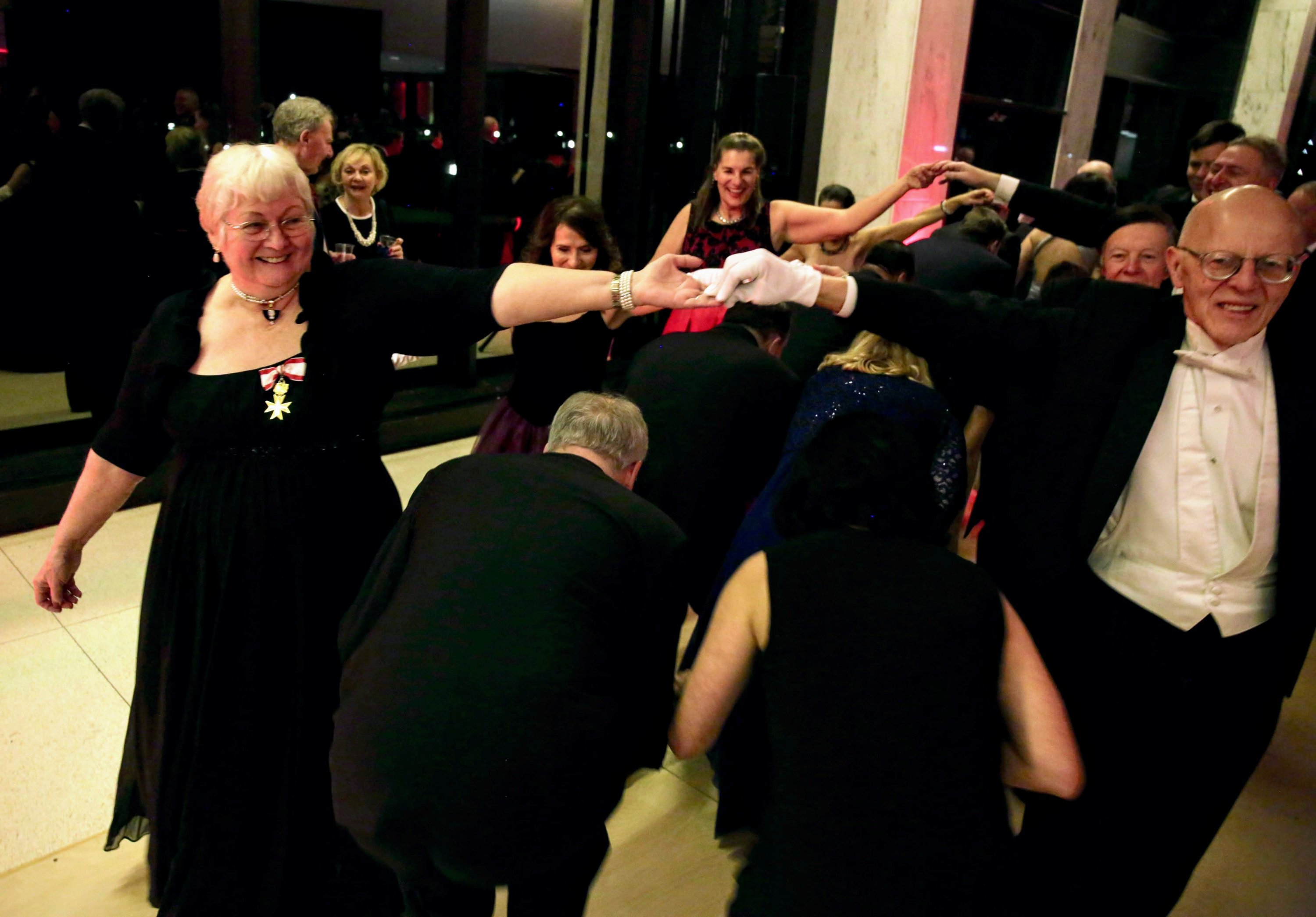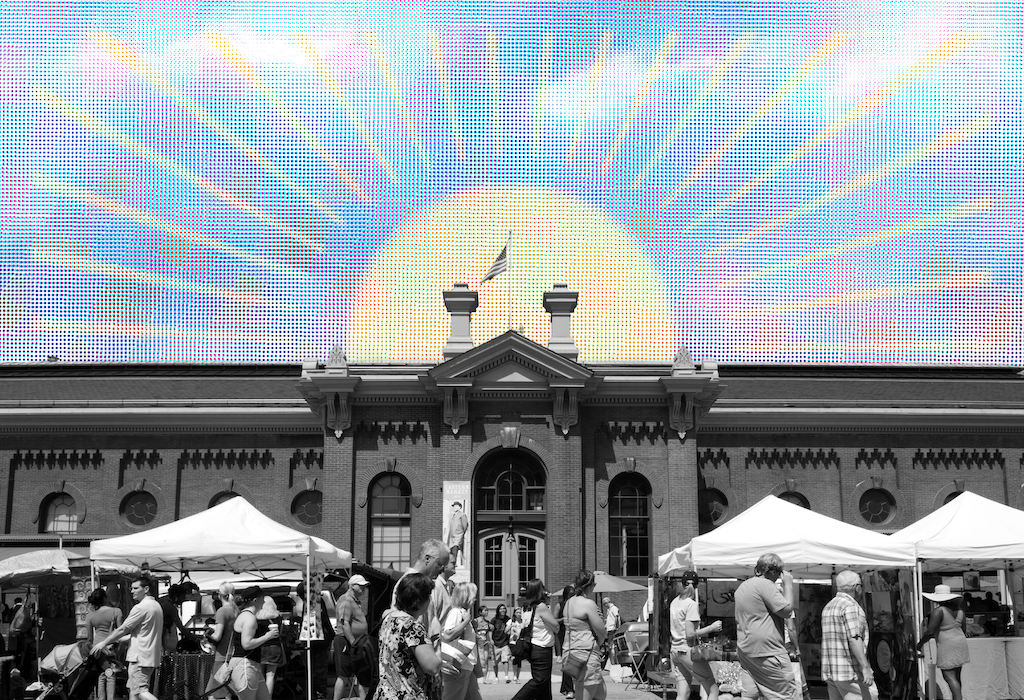Carol and Herbert Traxler, a married couple in their seventies, have been to more Austrian-style balls than you.
It’s probably not even close.
Carol and Herb, a pair of DC waltz instructors—known professionally as the Traxlers—lose track when asked to tally up the number of balls in their rearview mirror. They estimate they’ve been to more than 100 of them in the Washington area, as well as several dozen in Austria, Herb’s native country.
Which is why Saturday, December 8, 2018, is a staggeringly average day in the couple’s life. They’re holding court in the center of a ballroom in the French Embassy. Orbiting them is a merry-go-round of about 100 amateur dancers, trying to incorporate Herb and Carol’s tips (“Move in time with the music!” “Don’t take huge steps!”) as they sway to the waltz. For big chunks of the class, the Traxlers are busy reinforcing the rhythm. Herb claps with the beat. Carol lapses into a metronomic chant: “Right, 2, 3 . . . left, 2, 3 . . . right, 2, 3 . . . left, 2, 3 . . . .”
In an hour’s time, the International Club of DC’s annual winter Viennese ball is set to start. (Its usual setting, the Embassy of Austria, was unavailable this year.) The dancers’ dress suggests confidence—think billowing ball gowns, bow ties, and the occasional pair of opera-length, white satin gloves—but their demeanors are reminiscent of the nervous energy at a middle-school dance. They’re giddy with embarrassment. They bump into one another on the ballroom floor and apologize.
The Traxlers, though, are in their element, looking every bit the part of a veteran Viennese-waltz-teaching duo. Carol is tall and wears a long black frock and thin, gold-framed glasses. Her hair is cropped and white. Herb wears glasses too—his are the thick, bottle-bottom kind—but he doesn’t have any hair to speak of. His dancing tips, delivered in a mellifluous accent, are infused with Old World authority. Soon, both he and Carol will decorate their chests with the Republic of Austria’s Goldene Verdienstzeichen, or Decoration of Merit in Gold, a red-and-white badge awarded to each of them by the Austrian ambassador in 1998.

As the one-hour waltz class goes on, the dancing gets better, in part because the Traxlers know how to put people at ease. “Gentlemen, pick up a lady. You don’t get to keep her,” Carol quips when forming new pairs. She must have used that line countless times before, but she’s still getting some laughs. “Gentlemen, put your right hand between her ribs—not so low!”
By the time the class wraps up, the Traxlers’ latest batch of students are ready for the ball. Still, even the most gifted among them can’t waltz with the grace their teachers summon at 73. The students dance. The Traxlers hypnotize.
Since they began teaching the waltz in the 1990s, the Traxlers—known in the ballroom scene as Tanzmeisters, or dance masters—have taught thousands of Washingtonians. Over the years, they’ve taken their teaching talents to the White House, the Smithsonian, the Kennedy Center, Meridian International Center, and the National Museum for Women in the Arts, among other venues.
“It was definitely a different instruction than I’ve ever gotten. It was less instruction and more doing it. It’s like sink or swim, but that’s how you learn,” says Nick Canada, 26, who was at the December 8 class with his wife, celebrating their two-year anniversary. “The open bar helps.”
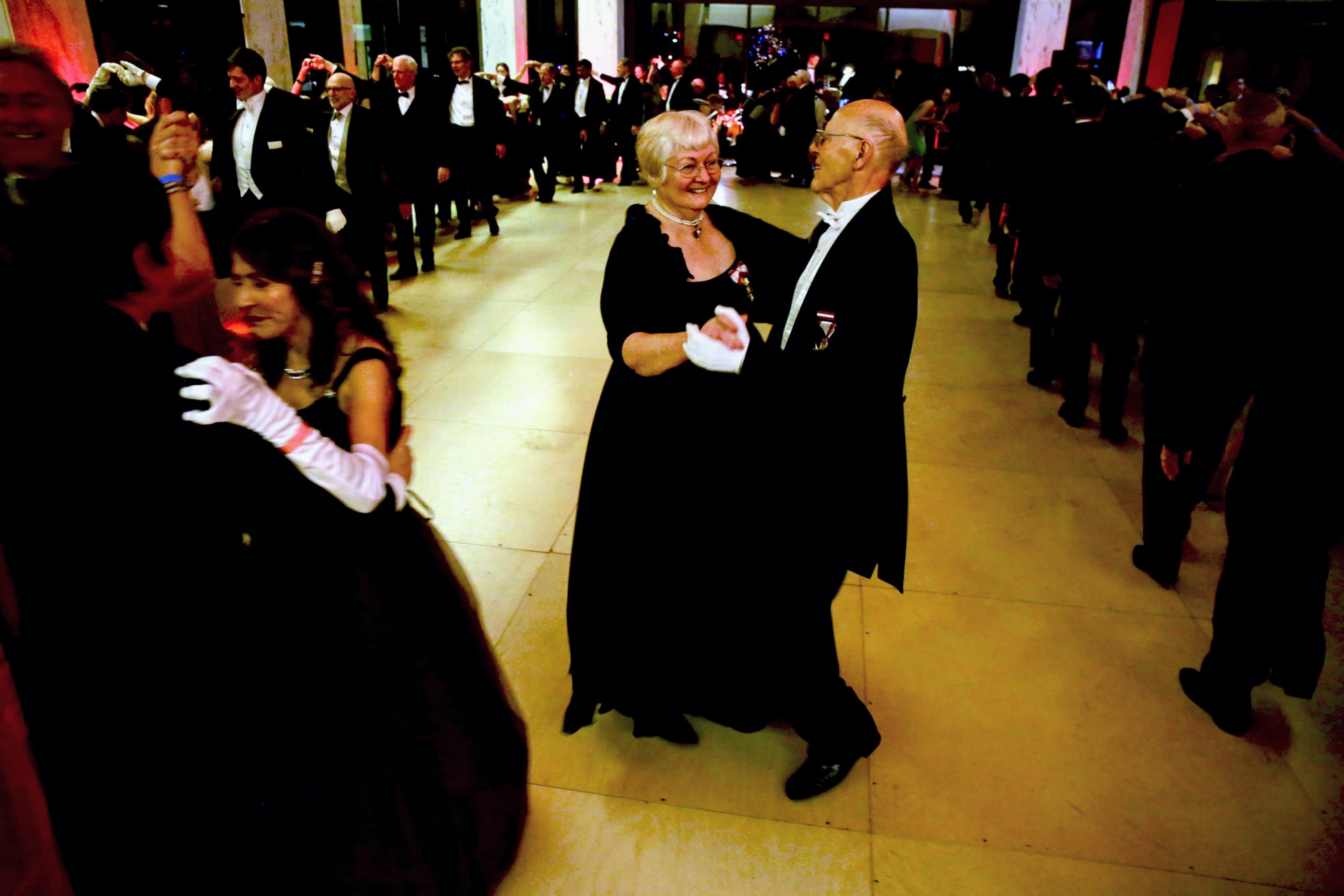
Herbert Traxler was born in Vienna in 1945. As a child, he spent four years with the Vienna Boys’ Choir. Tours took him to South Africa as well as to several countries in Europe, South America, and North America. As a student, Herb participated in the opening cotillion, or Eroeffnungskomitee, of many balls in Vienna. (There were plenty to choose from: The Austrian capital plays host to more than 450 balls a year.) After getting his economics PhD at Florida State University, Herb moved to DC in 1979, when he began a 23-year career at the US Public Health Service.
Carol’s path to DC also involved a Teutonic detour. After earning a BA in German at the University of Wisconsin, she moved to Germany, where she worked and studied in a number of different cities—Freiburg, Munich, and Nuremberg—before returning to the US. In 1984, she got her own PhD—at UCLA, in educational research methods. Early in her career, she worked with the US military in Germany and the Egyptian Ministry of Education. In the mid-’80s came a move to Washington, where Carol worked as a research scientist for more than 20 years.
Carol and Herb started becoming “the Traxlers” in 1987, when they met as fellow members of the Washington Saengerbund, a German folksinging group founded in 1851. Their first waltz together took place soon after their first official date; the couple’s 1988 wedding spawned a feverish cultural collaboration. In 1991, the Traxlers founded the Alpine Dancers, a folk-dance group that performs Austrian, German, and Swiss dances throughout the Mid-Atlantic. By the time the Austrian Embassy was looking for instructors to teach the waltz ahead of the 1997 Viennese Opera Ball, the Traxlers were already looming large in the local Austrian arts scene. They got the job.
It was a high-stakes waltz-teaching debut, with 700 people showing up for their eight-lesson series at the Austrian Embassy. One day, the Austrian ambassador pulled them aside. “He told us, ‘Would you have time for a special assignment?’ And of course we said yes,” Herb remembers.
That special assignment turned out to be waiting for them in the East Room of the White House, where the Traxlers were asked to prepare Chelsea Clinton and some of her friends for the Opera Ball. “She was a fabulous student,” says Carol. “She picked everything up lickety-split. The Clinton were proud parents, and rightly so.”
In a roundup of that 1997 ball for the Washington Post, Roxanne Roberts wrote that Chelsea “danced expertly several times,” a compliment that was probably as much a commentary on the First Daughter’s waltzing as it was on the Traxlers’ teaching.
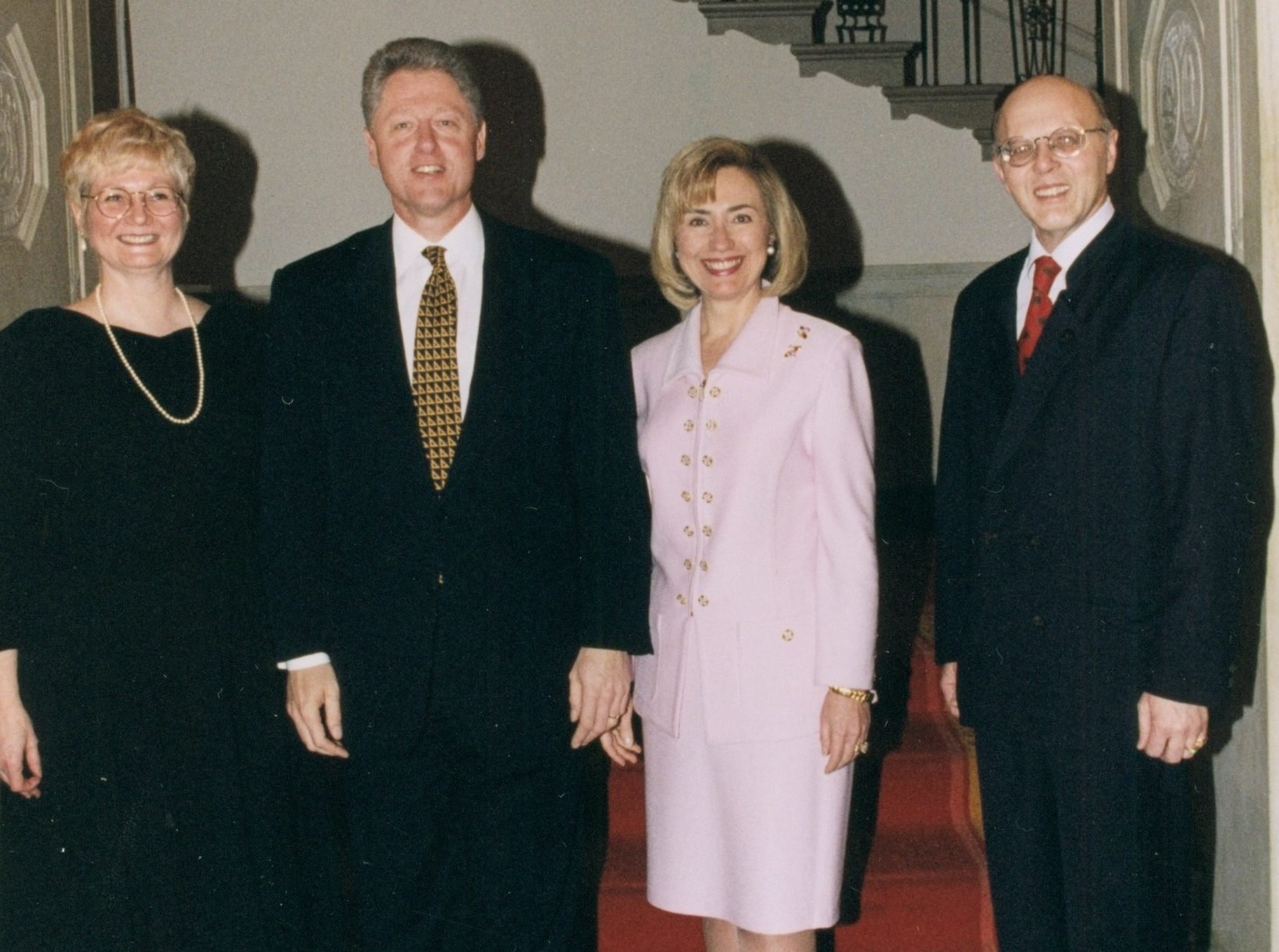
To most onlookers, the waltz can seem basic: just six steps that get repeated and a whole lot of turning. But good technique can be elusive.
“One of the challenging things about the waltz is the speed,” says Carol. “In competitions, for example, all dances are performed for three minutes. The Viennese waltz is for two minutes because it’s so fast that it’s very challenging in terms of stamina.” Indeed, where other waltzes are leisurely strolls, the Viennese waltz is a sprint, with a cruising speed of 180 beats per minute (compared with just 90 beats per minute for the mellower English waltz).
The Traxlers think their classes are effective because they replicate, by design, the conditions of a ball, from the choice of music to the number of people on the dance floor. “We get [our students] to enjoy being in a crowded ballroom,” says Carol. “Other dance teachers can teach for when you are performing by yourself and have all the space in the world. We don’t do that. We only do big group lessons, for the way people dance in Austrian balls.”
How do you whirl at top speed in a packed ballroom? How can you find the free space? How do you avoid collisions? These are all questions the Traxlers go over in their lessons.
Sanjaya Hettihewa, president of the International Club of DC, is familiar with the Traxlers’ teaching style. He remembers the pair fondly from a waltzing class he took with them more than two decades ago, and he has worked with them for every Austrian ball the International Club of DC has organized.
“The Traxlers are a treasure for the DC area,” Hettihewa says. “I think with how busy we are with DC work schedules, it’s a little time capsule to step back in time and experience culture as people used to enjoy it many years ago.”
Back at the ball, the Traxlers are kept busy by their various Tanzmeister duties. At 9:30 PM, they lead the Radetzky Grand March, a cheerful, bumbling procession meant to get everyone on the dance door—at one point in the march, couples have to run under the vaulted arms of their neighbors. At 10:30, they teach the Strauss Fledermaus Quadrille #6, a dance done in long lines in which a couple performs a series of charmingly anachronistic curtsies and nods with the couple in front of them.
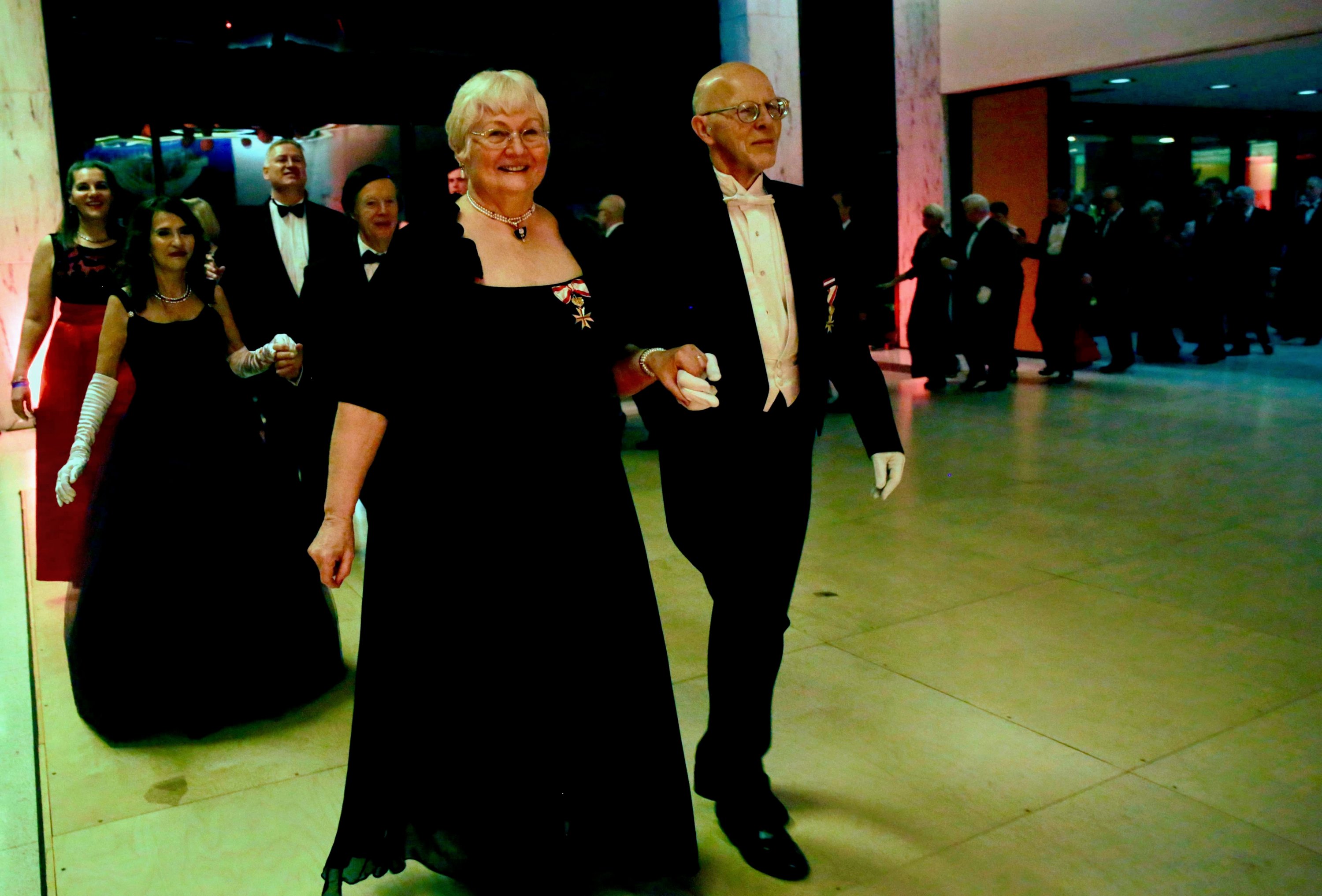
The Traxlers pull out the march and the quadrille at most of the balls they’re involved in. In 2018, that included all of the big events in the local ball circuit: the Christmas ball, the Organization of American States ball in February, the National Society of Arts and Letters ball in November, and another International Club of DC ball in the spring.
On January 12, the Traxlers will go to Vienna for a nearly monthlong stay. There, they’ll stop speaking English to each other and will switch to German. On the agenda are balls at places such as the Imperial Palace and the Vienna City Hall. (The ball season officially began in the 11th minute of the 11th hour of the 11th day of the 11th month of the year—that’s 11:11 AM on November 11—and will move into high gear in the new year.)
When they get back to Washington, they’ll know that a community of fellow waltz-dancers will be waiting.
“In DC, the ball culture in terms of the traditional Austrian balls has grown tremendously, and I think we both have a lot to do with it,” says Herb. “At least that’s what everybody tells us.”
